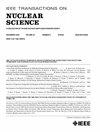Displacement Damage and Ionization Effects on Waveguide-Integrated Germanium-Silicon p-i-n Photodiodes
IF 1.9
3区 工程技术
Q3 ENGINEERING, ELECTRICAL & ELECTRONIC
引用次数: 0
Abstract
On-chip germanium-silicon (Ge-Si) photodiodes are critical elements in advancing the inclusion of silicon photonics in integrated circuit design. Understanding their radiation tolerance is essential for use in instrumentation that is operated in harsh environments, where the benefits of photonic integrated circuits (PICs) on performance and compactness are increasingly advantageous. Effects of contact configuration and geometry on waveguide-integrated Ge-Si photodiodes under 1.8-MeV proton and 10-keV X-ray irradiation are studied. Modest operating dark current increases up to 35 nA or 4.25 dB resulting from nonradiative defect center generation and ionization-induced traps. Radiation sensitivities are compared to thermal effects on performance, supporting the relative robustness of Ge-Si photodiodes to radiation. Annealing testing is performed to evaluate interface trap stability due to total ionizing dose (TID), which is dependent on the specific design of the photodiode. The increases in photodiode noise floors are modest overall but are important to design strategies for space and accelerator environments, especially as performance requirements and circuit complexity of integrated photonic technologies increase.波导集成锗硅p-i-n光电二极管的位移损伤和电离效应
片上锗-硅(Ge-Si)光电二极管是将硅光子技术应用于集成电路设计的关键因素。光子集成电路 (PIC) 在性能和紧凑性方面的优势日益凸显,因此了解它们的辐射耐受性对于在恶劣环境中运行的仪器的使用至关重要。在 1.8-MeV 质子和 10-keV X 射线辐照下,研究了接触配置和几何形状对波导集成 Ge-Si 光电二极管的影响。由于非辐射缺陷中心的产生和电离诱导陷阱,微弱的工作暗电流增加到 35 nA 或 4.25 dB。辐射敏感性与热效应对性能的影响进行了比较,从而证明了 Ge-Si 光电二极管对辐射的相对稳健性。退火测试用于评估总电离剂量(TID)导致的界面陷阱稳定性,这取决于光电二极管的具体设计。光电二极管本底噪声的总体增幅不大,但对太空和加速器环境的设计策略非常重要,特别是随着集成光子技术的性能要求和电路复杂性的提高。
本文章由计算机程序翻译,如有差异,请以英文原文为准。
求助全文
约1分钟内获得全文
求助全文
来源期刊

IEEE Transactions on Nuclear Science
工程技术-工程:电子与电气
CiteScore
3.70
自引率
27.80%
发文量
314
审稿时长
6.2 months
期刊介绍:
The IEEE Transactions on Nuclear Science is a publication of the IEEE Nuclear and Plasma Sciences Society. It is viewed as the primary source of technical information in many of the areas it covers. As judged by JCR impact factor, TNS consistently ranks in the top five journals in the category of Nuclear Science & Technology. It has one of the higher immediacy indices, indicating that the information it publishes is viewed as timely, and has a relatively long citation half-life, indicating that the published information also is viewed as valuable for a number of years.
The IEEE Transactions on Nuclear Science is published bimonthly. Its scope includes all aspects of the theory and application of nuclear science and engineering. It focuses on instrumentation for the detection and measurement of ionizing radiation; particle accelerators and their controls; nuclear medicine and its application; effects of radiation on materials, components, and systems; reactor instrumentation and controls; and measurement of radiation in space.
 求助内容:
求助内容: 应助结果提醒方式:
应助结果提醒方式:


